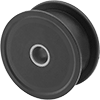Filter by
Shaft Diameter
Belt Trade Size
Bore Type
Rope Diameter
Pitch Diameter
For Use With
Bearing Type
For Maximum Belt Width
Weight Capacity
DFARS Specialty Metals
Export Control Classification Number (ECCN)
Power Transmission
Material Handling
Measuring and Inspecting
Facility and Grounds Maintenance
Building and Machinery Hardware









































